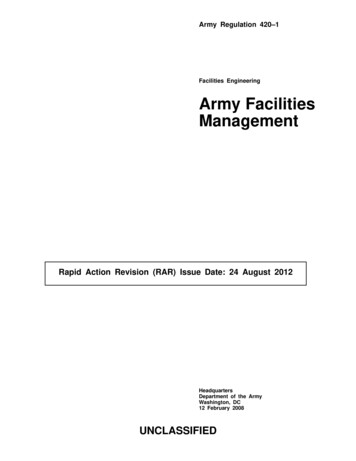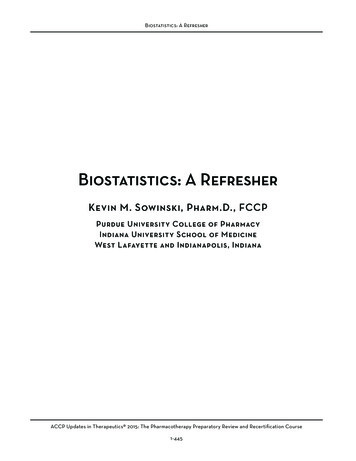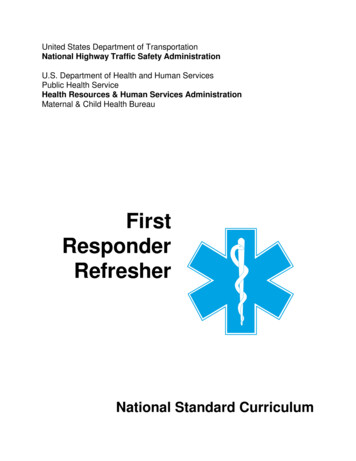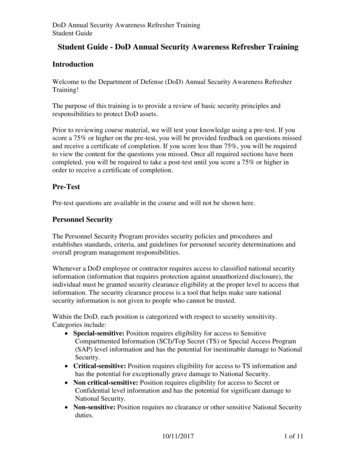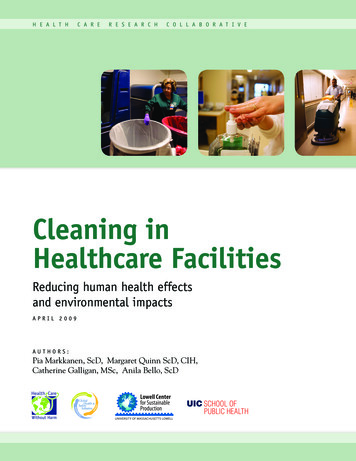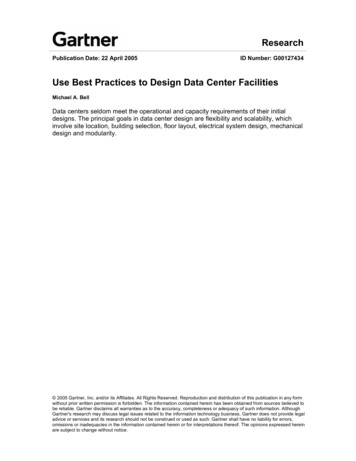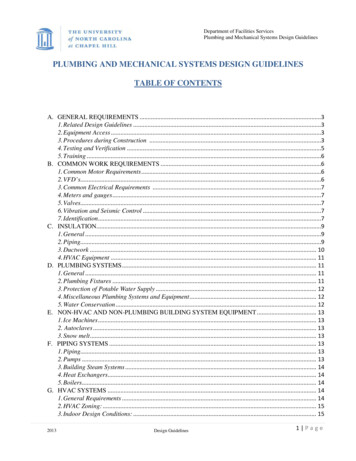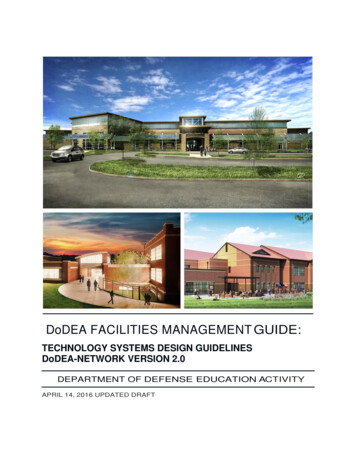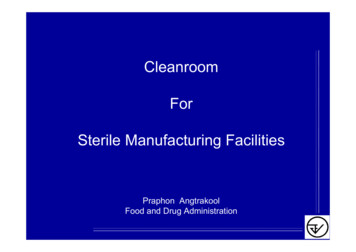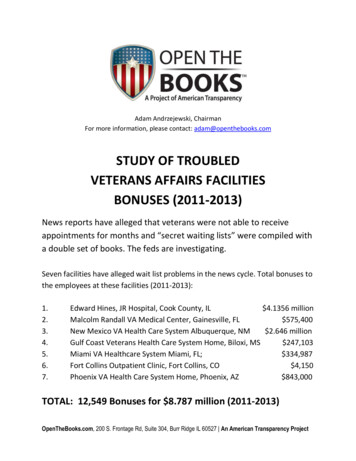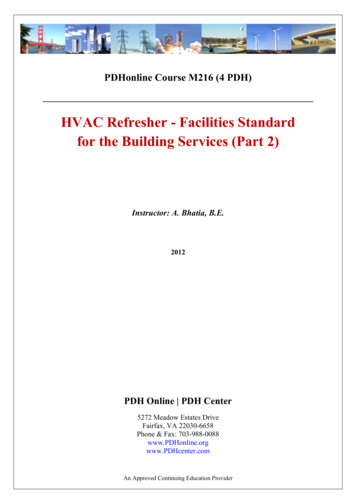
Transcription
PDHonline Course M216 (4 PDH)HVAC Refresher - Facilities Standardfor the Building Services (Part 2)Instructor: A. Bhatia, B.E.2012PDH Online PDH Center5272 Meadow Estates DriveFairfax, VA 22030-6658Phone & Fax: 703-988-0088www.PDHonline.orgwww.PDHcenter.comAn Approved Continuing Education Provider
www.PDHcenter.comPDH Course E216www.PDHonline.orgHVAC Refresher – Facilities Standardfor the Building Services (Part 2)A. BhatiaCourse ContentRULES OF THUMBSECTION # 1:AIR-CONDITIONING CAPACITY1) A ton of refrigeration (1TR) signifies the ability of air-conditioning equipment to extract heat @12000 Btu/hr. ASHARE (American Society of Heating, Refrigeration and Air-conditioningEngineers, Inc) has put together a table using national average data showing the Sq-ft/Ton 380Office3602801903) Each building is different and the design conditions differ greatly between regions to region.Factors to consider when figuring the sq-ft/ ton ratio include: Climate conditions (design temperatures) Expansive use of glass-particularly in the south and west orientations High ceilings-increasing the conditioned volume of the space Outside air requirements-especially important in high occupant load areas like conferencerooms and classrooms. Heat generating equipment – example computers, copiers, laser printers, big screen TV’setc. Lighting-especially the extensive use of incandescent and metal halide lights. Fluorescentlights are more efficient and burn cooler-however; their ballasts generate a fair amount ofheat.ApplicationAverage LoadResidence400-600 sq. ft. floor area per tonApartment (1 or 2 room)400 sq. ft. of floor area per tonChurch20 people per tonOffice BuildingLarge Interior340 sq. ft. of floor area per tonLarge Exterior250 sq. ft. of floor area per tonSmall Suite280 sq. ft. of floor area per tonPage 1 of 71
www.PDHcenter.comPDH Course E216ApplicationAverage LoadRestaurant200 sq. ft. of floor area per tonBar or Tavern9 people per tonCocktail Lounge175 sq. ft. of floor area per tonComputer Room50 – 150 sq. ft. of floor area per tonBank (main area)225 sq. ft. of floor area per tonBarber Shop250 sq. ft. of floor area per tonBeauty Shop180 sq. ft. of floor area per tonSchool Classroom250 sq. ft. of floor area per tonBowling Alley1.5 – 2.5 tons per alleywww.PDHonline.orgDepartment StoreBasement350 sq. ft. of floor area per tonMain Floor300 sq. ft. of floor area per tonUpper Floor400 sq. ft. of floor area per tonSmall Shop225sq. ft. of floor area per tonDress Shop280 sq. ft. of floor area per tonDrug Store150 sq. ft. of floor area per tonFactory (precisionmanufacturing)275 sq. ft. of floor area per tonGroceries – Supermarket350 sq. ft. of floor area per tonHospital Room280 sq. ft. of floor area per tonHotel Public Spaces220sq. ft. of floor area per tonMotel400 sq. ft. of floor area per tonAuditorium or Theatre20 people per tonShoe Store220 sq. ft. of floor area per tonSpecialty & Variety Store200 sq. ft. of floor area per tonIn general air-conditioning requirements are higher (200 to 400 sq-ft/Ton) for hot & humid regionsand lower (150 – 200 sq-ft/Ton) for cooler places.Note: The figures above indicative only. It is recommended to always generate a detailed heatingand cooling load calculation (such as using Manual J) for the building or space in question.AIR CONDITIONER CAPACITY RANGESThe application and unit capacity ranges are as follows:1) Room air conditioner - Capacity ranges 0.5 to 2 TR per unit, suitable for an area of not morethan 1000 square feet2) Packaged unit integral air-cooled condenser - Capacity ranges 3 to 50 TR, suitable for amaximum an area of 1000 – 10000 square feet3) Split system with outdoor air-cooled condenser - Capacity ranges 0.5 to 50 TR, suitable for anarea of 100 – 10000 square feetPage 2 of 71
www.PDHcenter.comPDH Course E216www.PDHonline.org4) Central air-conditioning chilled water system with air cooled condensers – Capacity ranges of20 to 400 TR, suitable for an area of 4000 sq-ft and higher5) Central air-conditioning chilled water systems with outdoor water cooled condenser - Capacityranges 20 to 2000 TR, suitable for an area of 4000 sq-ft and higher.COOLING CAPACITY SELECTER FOR HOMESAir conditioners are sized by cooling capacity in BTU's per hour. To estimate the optimum capacityfor any room, first calculate the size of the area to be conditioned by multiplying its width times itslength, measured in feet. Then select the cooling capacity needed using the table below, The BTU'sassociated with the square footage will give an approximate optimum for the space.Room AreaSquare FeetCooling Capacity (BTU range)10X15150up to 7.5X4015002800040X40160032000Notes to using the table aboveCooling capacities are based on rooms occupied by two people and having average insulation,number of windows, and sun exposure.To adapt the table for varying conditions, modify the capacity figures as follows:Reduce capacity by 10% if area is heavily shaded.Increase capacity by 10% for very sunny areas.Add 600 Btu/hr for each additional person if area is occupied routinely by more than two people.Add 4000 Btu/hr if area to be cooled is an average size kitchen.Add 1000 Btu/hr for every 15 sq/ft of glass exposed to sun.Add 3414 Btu/hr for every 1000 watts of electronic equipment.Page 3 of 71
www.PDHcenter.comPDH Course E216www.PDHonline.orgSUPPLY AIR REQUIREMENTS (MECHANICAL COOLING & HEATING)Equipment TypeApproximate AirflowRateExampleGas/Oil Furnace1 CFM per 100 Btu/hroutput64000 Btu/hr output furnace 640CFMElectric Furnace50 – 70 CFM per kWinput10kW furnace 10 x 70 700CFM30kW furnace 30 x 50 1500CFMElectric Air-conditioning400 CFM per ton30000 Btu/hr cooling30000/12000 2.5tons2.5 x 400 1000 CFMHeat Pump450 CFM per ton30000 Btu/hr cooling30000/12000 2.5tons2.5 x 450 1125 CFMNote the values vary significantly with the equipment. CFM/kW tends to be higher with smallestequipment (5-15kW) and lower as equipment becomes larger.In general, the following guidelines may be noted: 500 CFM/ton for Precision Air Conditioning 400 CFM/ton for Comfort Cooling Air Conditioning 200 CFM/ton DehumidificationSELECTION OF CHILLERSThe following is used as a guide for determining the types of liquid chillers generally used for airconditioning Up to 25 tons (88kW) – Reciprocating 25 to 80 tons (88 to 280kW) – Reciprocating or Screw 80 to 200 tons (280 to 700kW) – Reciprocating, Screw or Centrifugal 200 to 800 tons (700 to 2800kW) – Screw or Centrifugal Above 800 tons (2800 kW) – CentrifugalCircumstances Favouring Air-Cooled or Water Cooled SystemsCapacity Range (TR)Favourable System40 to 200Air-cooled chilled water system (explore the pros andcons of using multiple DX systems if possible)200 and aboveWater-cooled chilled water systemCHARACTERISTICS & TYPICAL APPLICATIONS OF VARIOUS COOLING SYSTEMSPage 4 of 71
www.PDHcenter.comPDH Course mBuilding HeightTypically limited to1- to 4-storyUnlimitedbuildingsMinimum Cooling CapacityNo limitation formodular systemsTypically costeffective forprojects 20tonsCooling ControlLowLow-moderate HighHighMaintenanceLowModerate-high ModerateHighInstalled CostLowModerate-high HighHighOperating Costs(energy and endent)Low1- to 2-storybuildings1- to 2-storybuildings inhot/dryclimatesTypical ApplicationsUnlimitedUnlimitedTypically costeffective forprojects 100tonsTypically costeffective for projects 200 tonsMedium to largefacilities withlimited access towater ormaintenanceMedium to verylarge facilities andcampusesCONVERTING KW/TON TO COP or EERIf a chiller's efficiency is rated at 1 KW/ton, the COP 3.5 and the EER 12kW/ton 12 / EERkW/ton 12 /(COP x 3.412)EER 12 / (kW/ton)EER COP x 3.412COP EER / 3.412COP 12 / (kW/ton x 3.412)RECOMMENDED EFFICIENCY VALUES FOR UNITARY & APPLIED HEAT PUMPSEquipment TypeAir Cooled(CSize Category 65,000 BtuhSub-Category orRating ConditionSplit System)Page 5 of 71RequiredEfficiency13.0 SEER
www.PDHcenter.comEquipment TypePDH Course E216Size Category(Cooling Mode)Air Cooled(Heating Mode)www.PDHonline.orgSub-Category orRating ConditionRequiredEfficiencySingle Package13.0 SEER 65,000 Btuh and 135,000 BtuhSplit System andSingle Package11.0 EER11.4 IPLV 135,000 Btuh and 240,000 BtuhSplit System and SinglePackage10.8 EER11.2 IPLV 240,000 BtuhSplit System and SinglePackage10.0 EER10.4 IPLVSplit System8.0 HSPFSingle Package7.7 HSPF47 F db/43 F wbOutdoor Air3.4 COP17 F db/15 F wbOutdoor Air2.4 COP47 F db/43 F wbOutdoor Air3.3 COP17 F db/15 F wbOutdoor Air2.2 COP 65,000 Btuh(Cooling Capacity) 65,000 Btuh and 135,000 Btuh(Cooling Capacity) 135,000 Btuh(Cooling Capacity)Water Source(Cooling Mode) 135,000 Btuh(Cooling Capacity)85 F Entering Water14.0 EERWater-Source(Heating Mode) 135,000 Btuh(Cooling Capacity)70 F Entering Water4.6 COPRECOMMENDED CHILLER PERFORMANCE LEVELSPage 6 of 71
www.PDHcenter.comPDH Course E216www.PDHonline.orgELECTRIC UTILIZATION INDEX (EUI)Electric utilization index (EUI) is the ratio of annual electricity consumption in kWh to the facility’ssquare footage.Type of BuildingCommon EUIGrocery61.0Restaurant38.9Hospital / Health16.4Retail12.1School / College10.3Hotel / Motel8.2Office7.5Misc. Commercial6.4Warehouse6.1HEAT GAIN FROM OCCUPANTS AT VARIOUS ACTIVITIES (At Indoor Air Temperature of78 F)Page 7 of 71
www.PDHcenter.comActivityPDH Course E216www.PDHonline.orgTotal heat, Btu/hAdult,maleSensibleheat, Btu/hLatentheat,Btu/hAdjustedSeated at rest400350210140Seated, very light work, writing480420230190Seated, eating520580255325Seated, light work, typing640510255255Standing, light work or walking slowly800640315325Light bench work880780345435Light machine work, walking 3miles/hr10401040345695Moderate dancing13601280405875Heavy work, lifting160016005651035Athletics200018006351165The values are for 78 F room dry bulb temperature. For 80 F dry bulb temperature, the total heatremains the same, but the sensible heat value should be decreased by approximately 8% and thelatent heat values increased accordingly.VENTILATION t2(people/1000ft )Dining rooms7020Cafeteria, fast food10020Bars, cocktail lounges10030Kitchen (cooking)2015Office space720Reception areas6015Conference rooms5020PublicSpacesSmoking lounge7060Retail stores,ShowroomsBasement & Street300.30Upper floors200.20Malls and arcades200.20Smoking lounges7060Beauty shops2525Hardware stores815Spectator areas15015Games rooms7025Playing rooms3020Ballrooms and discos10025Food andBeverageServiceOfficesSports andAmusementsElevators1.00Page 8 of 712
www.PDHcenter.comPDH Course nCFM/ft22(people/1000ft room5015Music sBedrooms30CFM/roomLiving rence rooms5020Assembly rooms12015Dry cleaning, laundry3030Gambling casinos12030Operating rooms2030Patient rooms1025Laboratories3020Procedure rooms2015Pharmacies2015Physical therapy2015Health CareFacilitiesEXHAUST AIR REQUIREMENTSExhaust Air RequirementsJanitor Closets10 Air changes/hrLocker Rooms10 Air changes/hrToilets10 Air changes/hrMechanical/Electrical Rooms12 Air changes/hrRooms with Steam System (Laundry)25 Air changes/hrBattery Rooms10 Air changes/hrTYPICAL DESIGN VELOCITIES FOR HVAC COMPONENTSEquipmentVelocity, Feet per minute(FPM)Intake Louvers Velocity (7000 CFM andgreater)400 FPMPage 9 of 71
www.PDHcenter.comPDH Course E216EquipmentVelocity, Feet per minute(FPM)Exhaust Louvers (5000 CFM and greater)500 FPMwww.PDHonline.orgPanel Filters Viscous Impingement200 to 800 FPMPanel Filters (Dry-Type, Pleated Media): Low Efficiency350 FPM Medium Efficiency500 FPM High Efficiency500 FPM HEPA250 FPMRenewable Media Filters Moving-Curtain Viscous Impingement500 FPM Moving-Curtain Dry-Media200 FPMElectronic Air Cleaners Ionizing-Plate-Type300 to 500 FPM Charged-Media Non-ionizing250 FPM Charged-Media Ionizing150 to 350 FPMSteam and Hot Water Coils200 min - 1500 maxElectric Coils Open WireRefer to Mfg. Data Finned TubularDehumidifying Coils500 FPMSpray-Type Air Washers300 to 600 FPMCell-Type Air WashersRefer to Mfg. DataHigh-Velocity, Spray-Type Air Washers1200 to 1800 FPMCENTRIFUGAL FAN PARAMETERSCentrifugal fans are by far the most prevalent type of fan used in the HVAC industry today. They areusually cheaper than axial fans and simpler in construction, but generally do not achieve the sameefficiency. Centrifugal fans consist of a rotating wheel, or "impeller," mounted eccentrically inside around housing. The impeller is electrically driven by a motor connected via a belt drive.ParametersBackward CurveForward ncy (%)78859070SpeedHighHighHighLowPage 10 of 71
www.PDHcenter.comPDH Course E216Parameterswww.PDHonline.orgBackward CurveForward CurveBCBIAFFCCostMediumMediumHighMed-LowStatic PressureVery highHighVery highLow (5 inch- w.g)(40in-wg)Power verloadingHousingScrollScrollScrollScrollAXIAL FAN PARAMETERSAxial fans consist of a cylindrical housing, with the impeller mounted inside along the axis of thehousing. In an axial fan, the impeller consists of blades mounted around a central hub similar tothose of an airplane propeller. Typically, axial fans are more efficient than centrifugal fans.ParametersPropellersTube AxialVane axialBlades2 to 84 to 85 to 20Maximum Efficiency (%)507585SpeedMediumHighVery highCostLowMediumHighStatic PressureLow (up to ¾ in)MediumHigh (up to 8 in)Power CurveNon-overloadingNon-o
1) Room air conditioner - Capacity ranges 0.5 to 2 TR per unit, suitable for an area of not more than 1000 square feet 2) Packaged unit integral air-cooled condenser - Capacity ranges 3 to 50 TR, suitable for a maximum an area of 1000 – 10000 square feetFile Size: 581KBPage Count: 72
